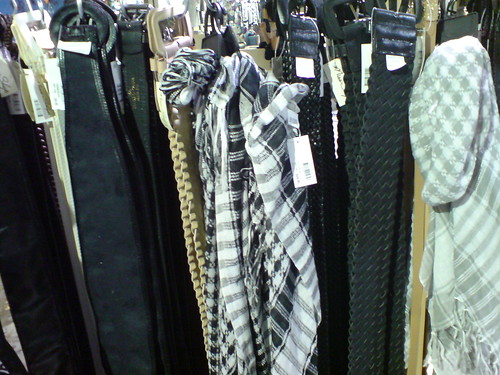
Keffiyeh-style scarves for sale in The Basement, Myer Melbourne.
Recently I was contacted by Dewi Cooke from The Age, who'd read my post about the keffiyeh. She's writing a story about the proliferation of this item in mainstream (not hipster) fashion. I've been meaning to do the same thing for months now, because it troubles two different ideas: that a) hipster style exists parallel to 'mainstream' style, sharing some of its motifs but remaining identifiable in itself; b) hipster style can be distinguished by its rapid-moving logic of early adoption and obsolescence.
I used to imagine a person inhabiting a 'hipster' cultural logic in a relatively stable way. I should add that I use 'inhabiting', rather than 'identifying with', because people don't tend to identify as hipsters, or admit a desire to be hip, except in self-deprecating ways (Indeed, you could argue that you instantly lose any hipness or coolness when you believe it of yourself or consciously realise you aspire to it; hipness is about insouciance), and I want to highlight a Bourdieuian concept of 'habitus' - a coherent set of knowledges and practices that produce one as a hipster.
Under this logic, you'd imagine that keffiyehs would be incredibly played out by now, and that if they're still around, they've lost their pseudo-subcultural hipness and are a mainstream accessory like any other. The fact that I spotted them yesterday in the Myer basement seems to support that "bubble-up" theory, as does the label on the scarf in question (apologies for my shaky hands):

It is hardly a Middle Eastern scarf now.
Thing is, I can't really endorse this "bubble-up" theory. The keffiyeh is now patently unconvincing as an authentic product of cosmopolitanism or politics (bought while travelling overseas, or in the knowledge of its political connotations - however abstracted or ironised). I'd like to raise the possibility that, rather than being cut loose and despised as a 'played' or uncool signifier, its continued popularity stems from its deployment by hipsters, and hence marks the mainstreaming of hipsterism.
I've always thought of hipsterism as a kind of gestalt organism that picked up and discarded tropes, and that if you were new to it, you had to be aware of the 'playedness' of particular things so you could avoid looking like a rube. But now I'm thinking about hipster generationism. Isn't it likely that people go through a 'phase' of hipsterism (from, say, age 16-25) and then other things in their lives take priority over the search for distinction? For one thing, hipsterism demands time, hedonism and research into the 'next thing', so it's well suited to students, whose habitus is already geared towards leisure, partying and information accumulation.
So, perhaps the continued run of the keffiyeh is simply its discovery by a new generation of hipsters. Perhaps hipster signifiers don't fall by the wayside in the manner I've imagined (picture a sad, sunbleached trucker hat lying in a ditch along with back issues of Vice magazine and albums by The Bravery and Clap Your Hands Say Yeah), but contribute to a cumulative hipster 'culture' to which young people want to aspire in and of itself? Maybe people no longer say "I want to be cool!" - they say, "I want to be a hipster!"
I don't know; I'm still thinking this through.